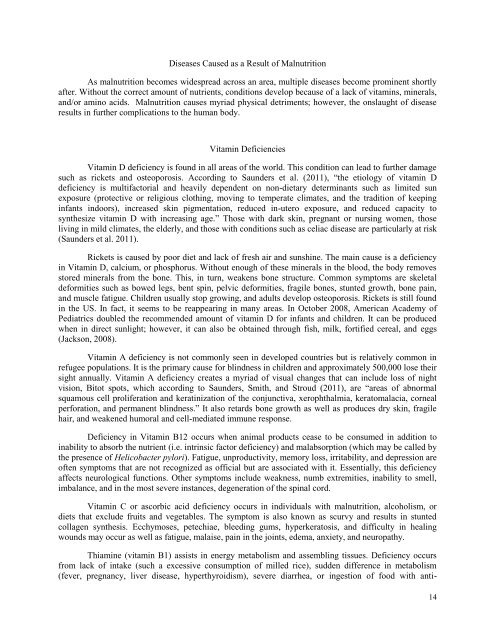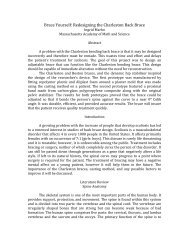Got Food? - the Scientia Review
Got Food? - the Scientia Review
Got Food? - the Scientia Review
You also want an ePaper? Increase the reach of your titles
YUMPU automatically turns print PDFs into web optimized ePapers that Google loves.
Diseases Caused as a Result of Malnutrition<br />
As malnutrition becomes widespread across an area, multiple diseases become prominent shortly<br />
after. Without <strong>the</strong> correct amount of nutrients, conditions develop because of a lack of vitamins, minerals,<br />
and/or amino acids. Malnutrition causes myriad physical detriments; however, <strong>the</strong> onslaught of disease<br />
results in fur<strong>the</strong>r complications to <strong>the</strong> human body.<br />
Vitamin Deficiencies<br />
Vitamin D deficiency is found in all areas of <strong>the</strong> world. This condition can lead to fur<strong>the</strong>r damage<br />
such as rickets and osteoporosis. According to Saunders et al. (2011), ―<strong>the</strong> etiology of vitamin D<br />
deficiency is multifactorial and heavily dependent on non-dietary determinants such as limited sun<br />
exposure (protective or religious clothing, moving to temperate climates, and <strong>the</strong> tradition of keeping<br />
infants indoors), increased skin pigmentation, reduced in-utero exposure, and reduced capacity to<br />
syn<strong>the</strong>size vitamin D with increasing age.‖ Those with dark skin, pregnant or nursing women, those<br />
living in mild climates, <strong>the</strong> elderly, and those with conditions such as celiac disease are particularly at risk<br />
(Saunders et al. 2011).<br />
Rickets is caused by poor diet and lack of fresh air and sunshine. The main cause is a deficiency<br />
in Vitamin D, calcium, or phosphorus. Without enough of <strong>the</strong>se minerals in <strong>the</strong> blood, <strong>the</strong> body removes<br />
stored minerals from <strong>the</strong> bone. This, in turn, weakens bone structure. Common symptoms are skeletal<br />
deformities such as bowed legs, bent spin, pelvic deformities, fragile bones, stunted growth, bone pain,<br />
and muscle fatigue. Children usually stop growing, and adults develop osteoporosis. Rickets is still found<br />
in <strong>the</strong> US. In fact, it seems to be reappearing in many areas. In October 2008, American Academy of<br />
Pediatrics doubled <strong>the</strong> recommended amount of vitamin D for infants and children. It can be produced<br />
when in direct sunlight; however, it can also be obtained through fish, milk, fortified cereal, and eggs<br />
(Jackson, 2008).<br />
Vitamin A deficiency is not commonly seen in developed countries but is relatively common in<br />
refugee populations. It is <strong>the</strong> primary cause for blindness in children and approximately 500,000 lose <strong>the</strong>ir<br />
sight annually. Vitamin A deficiency creates a myriad of visual changes that can include loss of night<br />
vision, Bitot spots, which according to Saunders, Smith, and Stroud (2011), are ―areas of abnormal<br />
squamous cell proliferation and keratinization of <strong>the</strong> conjunctiva, xerophthalmia, keratomalacia, corneal<br />
perforation, and permanent blindness.‖ It also retards bone growth as well as produces dry skin, fragile<br />
hair, and weakened humoral and cell-mediated immune response.<br />
Deficiency in Vitamin B12 occurs when animal products cease to be consumed in addition to<br />
inability to absorb <strong>the</strong> nutrient (i.e. intrinsic factor deficiency) and malabsorption (which may be called by<br />
<strong>the</strong> presence of Helicobacter pylori). Fatigue, unproductivity, memory loss, irritability, and depression are<br />
often symptoms that are not recognized as official but are associated with it. Essentially, this deficiency<br />
affects neurological functions. O<strong>the</strong>r symptoms include weakness, numb extremities, inability to smell,<br />
imbalance, and in <strong>the</strong> most severe instances, degeneration of <strong>the</strong> spinal cord.<br />
Vitamin C or ascorbic acid deficiency occurs in individuals with malnutrition, alcoholism, or<br />
diets that exclude fruits and vegetables. The symptom is also known as scurvy and results in stunted<br />
collagen syn<strong>the</strong>sis. Ecchymoses, petechiae, bleeding gums, hyperkeratosis, and difficulty in healing<br />
wounds may occur as well as fatigue, malaise, pain in <strong>the</strong> joints, edema, anxiety, and neuropathy.<br />
Thiamine (vitamin B1) assists in energy metabolism and assembling tissues. Deficiency occurs<br />
from lack of intake (such a excessive consumption of milled rice), sudden difference in metabolism<br />
(fever, pregnancy, liver disease, hyperthyroidism), severe diarrhea, or ingestion of food with anti-<br />
14
















